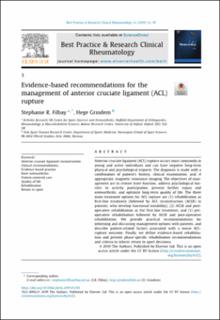Evidence-based recommendations for the management of anterior cruciate ligament (ACL) rupture
Peer reviewed, Journal article
Published version
Permanent lenke
https://hdl.handle.net/11250/2647272Utgivelsesdato
2019Metadata
Vis full innførselSamlinger
- Artikler / Articles [2119]
- Publikasjoner fra Cristin [1107]
Originalversjon
Best Practice & Research: Clinical Rheumatology. 2019, 33(1), 33-47. 10.1016/j.berh.2019.01.018Sammendrag
Anterior cruciate ligament (ACL) rupture occurs most commonly in young and active individuals and can have negative long-term physical and psychological impacts. The diagnosis is made with a combination of patient's history, clinical examination, and, if appropriate, magnetic resonance imaging. The objectives of management are to restore knee function, address psychological barriers to activity participation, prevent further injury and osteoarthritis, and optimize long-term quality of life. The three main treatment options for ACL rupture are (1) rehabilitation as first-line treatment (followed by ACL reconstruction (ACLR) in patients, who develop functional instability), (2) ACLR and post-operative rehabilitation as the first-line treatment, and (3) pre-operative rehabilitation followed by ACLR and post-operative rehabilitation. We provide practical recommendations for informing and discussing management options with patients, and describe patient-related factors associated with a worse ACL-rupture outcome. Finally, we define evidence-based rehabilitation and present phase-specific rehabilitation recommendations and criteria to inform return to sport decisions.
Beskrivelse
This is an open access article under the CC BY license (http://creativecommons.org/licenses/by/4.0/).
